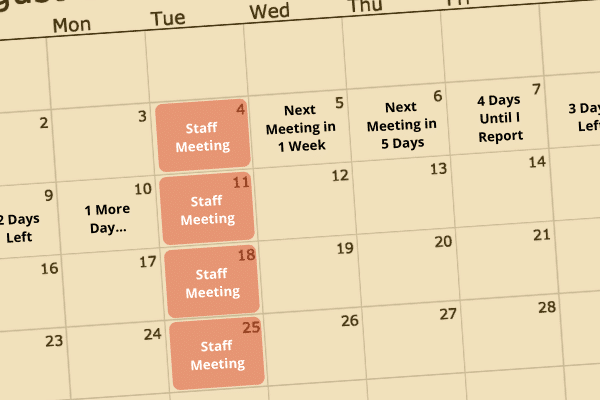
One of the most terrifying moments as a speaker is when you are sitting in a meeting, minding your own business, and someone asks you to stand up and give an impromptu speech. Surveys show that public speaking, in general, causes a lot of fear and nervousness. This nervousness can increase dramatically when the speaker has to create and deliver the speech off-the-cuff. In this session, we going to cover a few impromptu speech tips that you can use in these pressure situations. In addition, we will give you a few ways to improve your impromptu speaking skills as well.
Impromptu Speaking Tips
Realize that Many Impromptu Speaking Situations Aren’t Impromptu at All.

I was covering impromptu speaking in class years ago. One of the participants, said, “Thank God! That is what I have a lot of trouble with.” Curious, I asked him to elaborate. “Every Tuesday, we have a staff meeting. My boss always goes around the table asking us to give a report on our projects. It terrifies me.”
There was an awkward silence in the room. The woman sitting next to him raised her eyebrows and said, “Uhm, if it happened last Tuesday, and the Tuesday before, and the Tuesday before, doesn’t it stand to reason it will happen this Tuesday as well?”
Situations like this aren’t impromptu speeches. You have an opportunity to prepare for them and practice your delivery.
Realize that You Are Already an Expert at Speaking Off-the-Cuff

The point is that you have been creating impromptu speeches your entire life. You just didn’t realize it. If you get nervous when you are put on the spot, just think to yourself, “If Bob in accounting asked me that at the watercooler, how would I respond.”
Take a Deep Breath and Take Your Time Reponding.
When we panic, we tend to ramble. Basically, what happens is that we feel like we have to reply immediately to the request. We don’t take the time to think about our response before we start to speak. Then, half a sentence into the response we feel like we sound foolish, and then we scramble to try to recover.
This is normal and common. However, it doesn’t have to happen. When someone puts you on the spot, you don’t have to respond immediately. Instead, pause, take a deep breath and think about your response.
Stephen Covey used to say, Begin with the end in mind.” This is especially true in an impromptu speech. If you just start talking without knowing where you are going, that’s like jumping into your car and just driving in a random direction. You will only get to your destination if you know where you are going before you start.
Determine the Purpose of the Impromptu Speech.

If your purpose is to inform the audience, less is more. The old cliche is “I didn’t want to know how the watch was made, I just wanted to know what time it was.” The fewer points you cover, the better your audience will understand you. So, keep it simple.
For example, if your boss says, “Give us an update on the project,” she isn’t asking you to tell her EVERYTHING that has happened on the project. So, before you respond, take a breath and think to yourself, “What are the two, most important things that have happened on this project since my last report?” If she wants more details, she will ask.
If your purpose is to persuade, though, you have to use a different strategy. For instance, if your boss says, “Why should we invest company resources into this project?” you will still want to respond with concise evidence. However, the facts in and of themselves will likely not be enough to win over your audience.
Persuasive Impromptu Speech Strategies
The most important thing that you need to understand about persuasive speeches is that facts DO NOT persuade. I know that goes against conventional wisdom, but it is true. Human nature is interesting. For instance, if I tell you that I have a fact that is absolutely true, 100% of the time, human nature makes us want to test the statement. By nature, we are contrarians.
Some of you may be thinking, “I’m not sure that is actually true, Doug…” If you are, you just proved my point. So, when you are trying to persuade your audience, it is better to start with an example or story. Then, finish with your opinion or advice.
For additional details, see Example of a Persuasive Speech Outline.
Examples and Stories Are More Persuasive than a List of Facts.

“So why should we invest in this new software?”
“Well boss, a couple of days ago, I got a call from an angry customer upset because he had been overbilled. Instead of being able to pull his account up in my terminal, I had to put him on hold. Then, I reached out to accounts receivable. I didn’t have all the information that they needed, so I had to put them on hold, go back and ask a couple more questions of the customer. It was a frustrating process, and the customer just got more and more irritated. The new software can fix this problem.”
If I respond with a quick example or story, it is easier for the listener to understand why my solution will work. The boss can’t very well say, “That did not happen. No upset customer called you.” Since I’m using my own experience as proof, the argumentative phase of a persuasive discussion is removed entirely.
The technique doesn’t work every single time, but it does work more often then trying to use a list of facts or just your opinion to win over your audience.
A Little Trick to Help You Identify a Good Example WHen Under Pressure.
The human brain is a fantastic hard drive. It stores every incident that you have ever experienced. However, the human brain also has a series of filters for retrieving this data. If we didn’t have the filters, every memory that we have ever experienced would be constantly going on in our heads all the time. We’d be insane.
So, if you need to create a persuasive impromptu speech on the fly, you have to bypass those filters. A good way to do this is to try to focus your brain on a specific incident related to the fact or opinion that you have. In your head, just ask yourself, when was a time that I experienced this?” Also effective is the phrase, “That reminds me of the time…”
Try it out. For instance, if I say, persuade me to be on time for appointments, just pause and ask yourself, “When was a time that I was late for an appointment and it cost me?” Or you might try… “Late for an appointment… That reminds me of the time…”
Most likely, an image popped into your head related to that topic. That image is a memory of a time related to the topic.
Finish Your Persuasive Impromptu Speech With Your Opinion or Action.
Once you deliver your incident or example, make sure to finish with your action or example. These tend to come naturally after you tell a story. For instance, many people will finish by saying, “The moral of the story is…”
Basically, you want to reinforce your point only AFTER you have gotten the audience to agree with your evidence. The example gets the audience moving in your direction. Then the moral of the story gives your audience a call to action.
The technique works really well, and you can create the entire persuasive speech in seconds.
How to Improve Impromptu Speaking Skills
Each of these impromptu speech tips takes practice to master. A good place to practice them is in other prepared speeches. For instance, if someone asks you a question in a formal speech, you can use the techniques to answer. We also practice impromptu speaking in every session of our virtual public speaking class. So, if you really want to master this skill, join us for the weekly sessions of Fearless Presentations ®.

